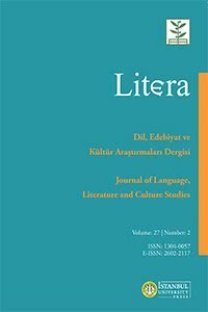The Shattering Symmetries between the Imaginary and the Symbolic in Carter’s The Magic Toyshop
Angela Carter, The Magic Toyshop, Lacan, literature, psychoanalysis
___
Armitt, L. (2000). Contemporary Women’s Fiction and the Fantastic. Basingstoke: Macmillan.Butler, J. (2000). Antigone’s Claim. New York: Columbia UP.
Carter, A. (1996). The Magic Toyshop. New York: Penguin.
Day, A. (1998). Angela Carter: The Rational Glass. Manchester, UK: Manchester UP.
Eagleton, T. (1983). Literary Theory. Oxford: Blackwell.
Freud, S. (1939). Moses and Monotheism. (K. Jones, Trans.). New York: Vintage.
Gamble, S. (1997). Angela Carter: Writing from the Frontline. Edinburgh: Edinburgh UP.
Jouve, N. W. (2007). Mother is a Figure of Speech... In L. Sage (Ed.), Essays on the Art of Angela Carter Flesh and the Mirror (pp.151-183). London: Virago.
Lacan, J. (2006). Écrits, The First Complete Edition in English. (B. Fink, Trans.). New York: W.W. Norton.
---.(1991). Le Séminaire, Livre XVII: L’envers de la psychanalyse (text established by J.A. Miller). Paris: Seuil.
---. (1993). The Psychoses: The Seminar of Jacques Lacan Book III.In J. A. Miller (Ed.). (R. Grigg, Trans.). London: Routledge.
---. J.(1992). The Seminar of Jacques Lacan Book VII The Ethics of Psychoanalysis 1959-1960. In J.A. Miller (Ed.), (D. Porter, Trans.). New York: W.W. Norton.
Lloyd, M. (2007). Judith Butler: From Norms to Politics. Cambridge: Polity P.
Müller, A. (1995). Angela Carter Identity Constructed / Deconstructed. Heidelberg: Universitätverlag C. Winter.
Palmer, P. (1987). From ‘Coded Mannequin’ to Bird Woman: Angela Carter’s Magic Flight. In S. Roe (Ed.), Women Reading Women’s Writing (pp.179-205). Brighton: Harvester P.
Peach, L. (2009). Angela Carter. (2nd ed.) Houndmills, Basingstoke, Hampshire and New York: Palgrave Macmillan.
Sage, L. (2007). Introduction. In L. Sage (Ed.), Essays on the Art of Angela Carter (pp.20-42). London: Virago.
Sarup, M. (1992). Jacques Lacan. New York: Harvester Wheatsheaf.
Wyatt, J. (2000). The Violence of Gendering: Cartesian Images in Angela Carter’s The Magic Toyshop, The Passion of New Eve, and ‘Peter and the Wolf.’ In A. Easton (Ed.), Angela Carter (pp.58-83). Houndmills, Basingstoke, Hampshire: Palgrave Macmillan.Žižek, S. (2000). Class Struggle or Postmodernism? In E. Laclau, J. Butler and S.
Žižek (Eds.), Contingency, Hegemony, Universality: Contemporary Dialogues on the Left(pp.90-11).London and New York: Verso.
- Yayın Aralığı: Yılda 2 Sayı
- Yayıncı: İstanbul Üniversitesi
Memory Space in the Works of Patrick Modiano
Edward Bond’un Sandalye Oyunları’nda İktidar
Cüneyt ÖZATA, Ahmet Gökhan BİÇER
Müziğin Ruhunu Yansıtan Anlatı Örnekleri: Ravel ve Dünyanın Tüm Sabahları
Sözceleme Kuramı Çerçevesinde “Biz” Adılının İncelenmesi
Fransa’daki Üniversite Öğrencilerinin Yabancı Dil Olarak Türkçe Öğrenme Nedenleri
Haruki Murakami’nin Hipertextlerinde Performatif İşlevli Hikâye Anlatımı: Dün ve Şehrazad
The Shattering Symmetries between the Imaginary and the Symbolic in Carter’s The Magic Toyshop
